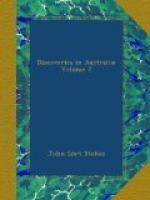CHAPTER 2.13.
Exploration of Interior.
Twofold Bay.
Survey of Bass Strait.
Dangerous situation of the Beagle.
Kent and Hogan Groups.
Gipps Land.
Wilson’s Promontory.
The Tamar.
Eastern entrance of Strait.
Steam communication between India and Australia.
New Guinea.
Straitsmen.
North coast of Tasmania.
Aborigines.
Port Phillip.
Directions for ships passing King Island.
Complete survey of Bass Strait.
Farewell to Sydney.
Moreton Bay.
The Comet.
State of Tasmania, or Van Diemen’s Land.
Lighthouses in Bass Strait.
EXPLORATION OF INTERIOR.
The most interesting topic of conversation on our arrival at Sydney was the projected expedition into the interior. Two candidates for this important and deeply interesting undertaking had presented themselves—Mr. E.J. Eyre and Sir Thomas Mitchell, both experienced Australian explorers. The latter proposed to start from Fort Bourke on the Darling; and the former from Moreton Bay. In my own humble opinion, strengthened by recent experience, neither of these are practicable routes;* or at any rate, they are not the best that could be selected. The centre of the continent must be reached by the shortest possible journey; it being advisable to avoid the despondency that seizes on a party during a protracted expedition, and to keep up throughout a certain degree of excitement. As, therefore, the greatest indentation on the shores of the continent is the Gulf of Carpentaria, the head of the Albert River, which discharges its waters into the bottom of it, is unquestionably the best point of departure that could be selected, being one-half the distance of Fort Bourke from the centre, and two-thirds nearer than Moreton Bay.
(Footnote. Whilst this sheet was going through the press, the report of our greatest Australian traveller, Captain Sturt, reached England; wherein he writes, speaking of his furthest (February 1845) in latitude 28 degrees South and longitude about 141 degrees 22 minutes East having apparently entered the central desert, as follows: “I could see no change in the terrible desert to which I had penetrated. The horizon was unbroken by a single mound, from north round to north again, and it was as level as that of the ocean. My view to the north extended about eight miles, but I did not venture to compass that distance, only perhaps to have overlooked a similar heart-rending and desolate scene.” This bears out the opinion expressed in the text. I do not hesitate, however, in the face of the interesting evidence brought forward by Captain Sturt, still to doubt the existence of an inland sea. I think the high temperature he experienced contradicts such an hypothesis; and I believe the large expanse of water, reported by the natives, to be the Gulf of Carpentaria, which bore about north (true) six hundred miles from his position, Moreton Bay being nearly equidistant on an east bearing, whilst Adelaide bore South by West 1/2 West about four hundred and thirty miles.




